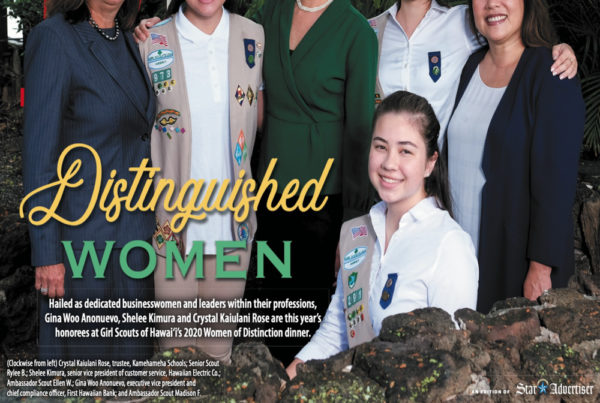Honolulu Star-Advertiser
April 13, 2019
by MINDY PENNYBACKER
 Student-to-student program provides support, education and fun
Student-to-student program provides support, education and fun
The classroom at Palolo Elementary School resounded with a happy din as eight high school students and 11 fifth-graders assembled for their final after-school mentoring session, supervised by adult staffers from YouthGrace, a local nonprofit organization.
The youngsters sat and rolled about in a wide circle on the floor, batting a ball rapidly back and forth while calling out the alphabet. As they played they joked and talked story, and wild hits produced excited screams from both the teenagers and younger kids.
For an hour once a week, YouthGrace brings volunteers from a high school to mentor children, one on one, at a partner elementary school.
“We usually do some journaling with a prompt, like what dreams you have, or if you want to learn something new, what would it be — open-ended questions,” said Leilani Zbin, 18, a poised, clear-eyed student from Kaimuki Christian School. “We’re trained to mostly listen.”
Caroline Kerat, a tall 12-year-old in a yellow floral smock, stood attentively beside Zbin. Asked if they do homework together, “I help if she needs it, but she usually doesn’t and so we play,” Zbin said.
“Homework’s easy for me,” Kerat said.
For a moment, verdant Palolo Valley felt like Brigadoon: In a digital age, with schools emphasizing technical skills and in-person face time fading behind the glare of screens, here were children happily engaged in conversation, reading, writing and problem-solving, and play involving traditional books, pencils, paper, puzzles, board games and balls.
“We’ll never have a mentor bot, I’ll tell you that right now,” said Jay Jarman, YouthGrace executive director, who founded the organization in 2015 and is now re-branding it as Malama Mentors because the word “grace” has produced “a little bit of pushback from (Department of Education) schools we work with.”
The name change takes effect Monday. “We’re not religious, and we want to let people know that,” Jarman said.
The organization’s mission is to help develop confidence, motivation to succeed and relationship skills in children lacking close, supportive family and social networks, Jarman said. An exclusive focus on youth-to-youth mentoring distinguishes YouthGrace from volunteer organizations such as Big Brothers Big Sisters in which children are mentored by adults.
Because the mentors are themselves so young, YouthGrace serves grade schoolers who need extra attention but aren’t severely challenged.
“Kids with psychological or behavioral issues are too hard for high school mentors to handle,” Jarman said. “We succeed with ‘remote risk’ elementary school children — the lonely, shy, unencouraged kids.”
Jane Toyama, principal of Kuhio Elementary School, which pairs with Kaimuki High School in the YouthGrace program, said this fills a need.
“Our teachers recommend children who are withdrawn, have few friends, are from broken homes or latchkey kids. There may be a concern about their being bullied or (other) trauma, but they’re not at high risk.”
Sandra Salas, a Kuhio Elementary fifth-grade teacher, said of the program, “It’s helping my students talk to peers, opening them up more to sharing about their feelings and what they want to do in the future.” She appreciated that “they’re dropping tech for a moment to feel and listen to their surroundings.”
Something as simple as chatting while playing games, Salas observed, “gives them that human connection, that sense of belonging somewhere in the world versus being alone in cyberspace.” For example, she said, “It’s easy to tell somebody ‘I’m mad at you’ in a text, but face to face you can feel and see and fix it together.”
Kerat, the Palolo fifth-grader, said she confided in Zbin. “Sometimes I tell Leilani about my family. I’m in a foster home.”
“We’re here to help if they have troubles at home,” Zbin said.
YOUTHGRACE grew out of Common Grace, a program Jarman started in 2003 with neighborhood church members mentoring students at elementary schools. It now has a network of 17 mostly public schools and an annual budget of approximately $85,000.
Jarman, a New Mexico native and 40-year Hawaii resident with a doctorate in divinity, credits veteran public school counsellor Michael Kawamoto, 56, with the idea.
While a counselor at Kalihi Waena Elementary, Kawamoto appreciated the Common Grace mentors who volunteered there. After transferring to Kaimuki High, he asked Jarman to consider training student volunteers. “I thought how little kids just look up to teenagers,” Kawamoto said.
YouthGrace benefits high school kids as well, he said. “I had a shy, withdrawn, special ed student last year who was bullied in elementary school. He turned out to be a fantastic mentor, so warm and loving to this boy at Kuhio Elementary,” and is now attending Kapiolani Community College while working part time.
Mentoring also impresses college admissions departments, Kawamoto added.
Another of his proteges, Kaimuki High senior Dennis Trotter, was on the receiving end of Common Grace mentoring at Kaimuki Christian’s elementary school and is now in his second year of helping students at Kuhio Elementary.
“The main focus is creating social stability with the kids so they can cooperate,” said Trotter, a right fielder on his school’s baseball team who plans to major in atmospheric science in college. “The academics just comes along with it,” he said, adding the kids he’s worked with have grown less shy and more open.
IN THEIR last meeting, each YouthGrace mentor dons a graduation robe and cap for a photo with their young partner, and the younger children are invited to attend the high schoolers’ commencement ceremonies.
They are also asked to write down what they most appreciate about each another and read it aloud.
“You show respect to me,” said Neivon Richard to her mentor, Nikolas Chun.
“You’re hardworking and kind,” said Batsi Petewon, Chun’s other partner.
Chun said he tends to be quiet and shy, and appreciated that both girls were outgoing, high-spirited and fun.
Each session includes outdoor play, and this one wound up with a scavenger hunt. The children ran around the hilly campus beneath the folded cliffs of the Koolaus. Across the street, in the yards of wood-frame houses, mango trees were in full red blossom.
When the group reconvened for prizes and pizza, faces flushed and eyes glowing, one realized that every child had a roomful of friends. An hour a week, over a few months, can shape a bright and lasting legacy.







